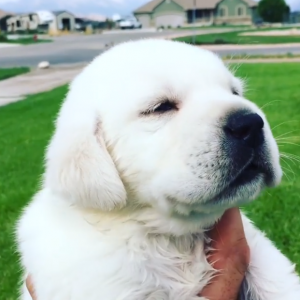
@rockyriverretrievers on Instagram
The “Stay” command is helpful to teach your dog. The process includes teaching stay in phases and teaching the behavior in reverse, beginning at the end and moving backward for longer, more dependable stays.
Establish a Beginning & End
‘Stay’ is a two-part command; after commanding your dog to ‘stay’, it’s important to let them know when they can move again. Try combining your stay command with a release phrase that signifies the end of the stay. “OK,” “Free,” “Release,” and “All Done” are all common release phrases. When the “stay” is over, choose one word as your release word and utilize it regularly.
Posture your dog in a sit, down, or stand position to teach the release word. Then give your dog a ‘Stay’ order, followed by your release word and reward nearly immediately. If your dog does not move after hearing the release word, don’t worry. To signal that it is OK to proceed, you might take a step back, clap your hands, or engage in other positive engagement.
Common Mistakes Owners Make
If you have food in your hand, don’t command your dog to stay. Your dog will be enticed to follow you if you do this.
Do not always call your dog to come to you when they are staying with you; he’ll be expecting a recall as a result of this. Before saying the release word, practice leaving and returning to your dog.
Duration, Distance, and Distractions
You’re ready to go on to the following stage after you’ve successfully coupled a release word with your stay command. These are known as the Three D’s by dog trainers: Duration, Distance, and Distractions.
Duration
The duration of your dog’s stay is the amount of time he spends there. To begin, place your dog in a sit, down, or stand posture. Give your remaining command without counting to three, and then use your dog’s release word to let him go. By two to three-second intervals, lengthen the time you ask your dog to stay. If your dog violates his stay, restart the timer and ask him to stay for a shorter period.
Distance
Distance refers to moving away from your dog, and it is typical for owners to hurry to this stage of training. Teaching distance is best done half step by half-step. Place your dog in the desired position and give him the remaining order. Step back with one foot, lean back, and then return to your dog and let him go. Release your dog and give them a treat after taking a complete step back. Slowly increase the number of steps, one at a time.
Distractions
Distractions are anything that occurs during your dog’s stay, no matter how large or tiny. Before you add distractions, make sure you have a solid foundation with your release word, stay time, and distance. Start with something simple at home or in the backyard when adding distractions, and work your way up to greater distractions in other situations.
In Conclusion
Teaching your dog to ‘stay’ can be a challenge, but it’s a necessary command to learn to keep your dog not just disciplined but safe. Remember to be patient and that practice makes perfect. Soon enough your pup will be able to listen and obey your commands.
Here’s a link to some training treats to help you out.
Check out our pups!
Here’s a video that might help:

